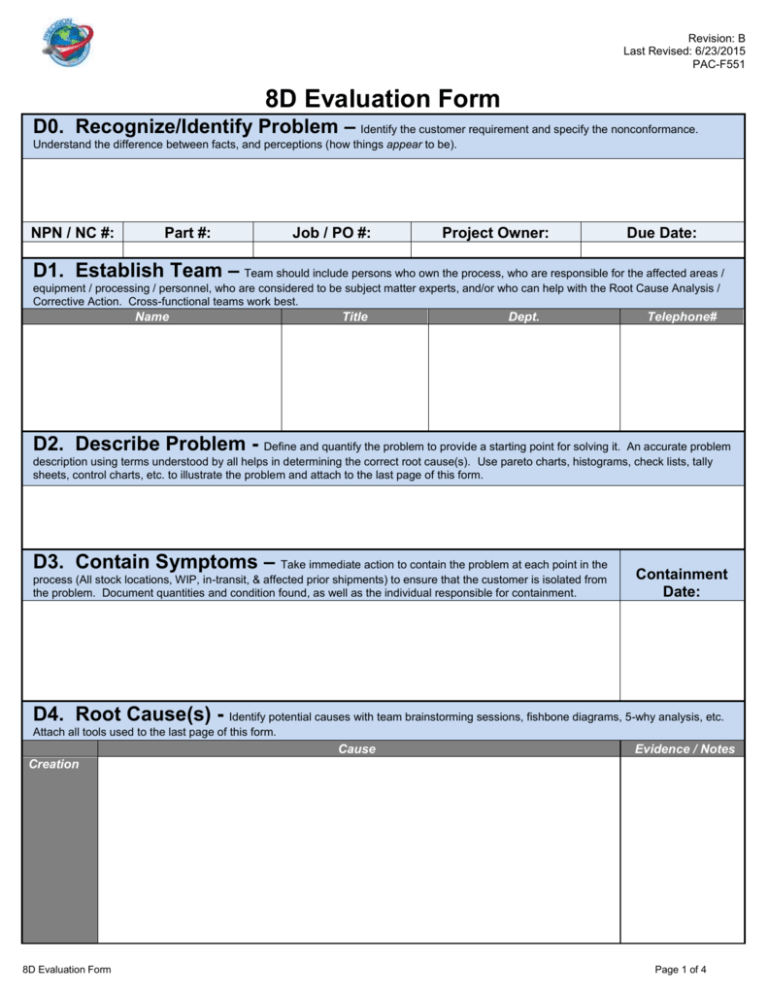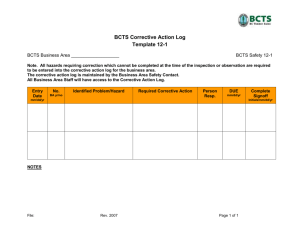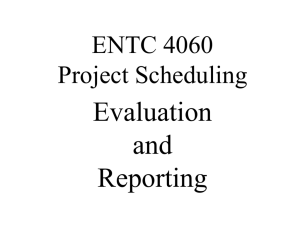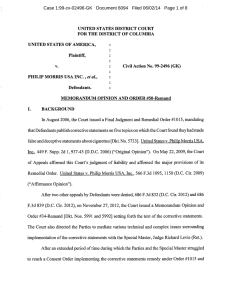8D Evaluation Form | Problem Solving & Corrective Action
advertisement

Revision: B Last Revised: 6/23/2015 PAC-F551 8D Evaluation Form D0. Recognize/Identify Problem – Identify the customer requirement and specify the nonconformance. Understand the difference between facts, and perceptions (how things appear to be). NPN / NC #: Part #: Job / PO #: Project Owner: Due Date: D1. Establish Team – Team should include persons who own the process, who are responsible for the affected areas / equipment / processing / personnel, who are considered to be subject matter experts, and/or who can help with the Root Cause Analysis / Corrective Action. Cross-functional teams work best. Name Title Dept. Telephone# D2. Describe Problem - Define and quantify the problem to provide a starting point for solving it. An accurate problem description using terms understood by all helps in determining the correct root cause(s). Use pareto charts, histograms, check lists, tally sheets, control charts, etc. to illustrate the problem and attach to the last page of this form. D3. Contain Symptoms – Take immediate action to contain the problem at each point in the process (All stock locations, WIP, in-transit, & affected prior shipments) to ensure that the customer is isolated from the problem. Document quantities and condition found, as well as the individual responsible for containment. Containment Date: D4. Root Cause(s) - Identify potential causes with team brainstorming sessions, fishbone diagrams, 5-why analysis, etc. Attach all tools used to the last page of this form. Cause Evidence / Notes Creation 8D Evaluation Form Page 1 of 4 Revision: B Last Revised: 6/23/2015 PAC-F551 Escape D5. Select / Verify Corrective Actions - Identify potential solutions that address the root cause(s). Corrective actions to be evaluated for effectiveness using a decision-based analysis process such as a Process Failure Mode Effects Analysis (PFMEA). List corrective actions or dismissal reasoning for all root causes. Verification Utilize the Action Item page to document action plans. D6. Implement / Validate Corrective Actions - Ensure that corrective action does "what it is supposed to do." Allows for the detection of any undesirable side effects. Utilize tools like error-proofing and process improvement, Poka-Yoke, natural mappings, visual factory, standard operating procedures (SOP), control charts (let the data illustrate process improvement), etc. If desired results were not achieved return to D4. Implementation Date: D7. Prevent Recurrence - Take the appropriate steps to ensure that the problem does not occur again by updating supporting engineering and quality documents (PFMEA, control plan, in-process masters, process flow charts, etc.), identify/implement changes to areas that allowed the problem to occur/escape (systems, practices, procedures, specifications, etc.), and identify/implement RCCA on any similar products that could exhibit a similar failure. Implementation Date: D8. Recognize Team - Acknowledge / recognize team, celebrate successful completion, ensure documentation/information storage is completed for easy retrieval, review metrics for identification of next opportunity. Name / Signature 8D Evaluation Form Title Telephone # Closure Date Page 2 of 4 Revision: B Last Revised: 6/23/2015 PAC-F551 Action Item Table Date Action Assigned Action Item Detail / Description 8D Evaluation Form Action Item Owner Action Item Date Due Action Date Date Completed Verified How Verified Status (Open/ Closed) Page 3 of 4 Revision: A Last Revised: 11/25/2013 PAC-F551 Note: The following page(s) can be used to attach supporting 8D information / data (digital photos, process flow diagrams, dimensional results, etc.). 8D Evaluation Form Page 4 of 4







